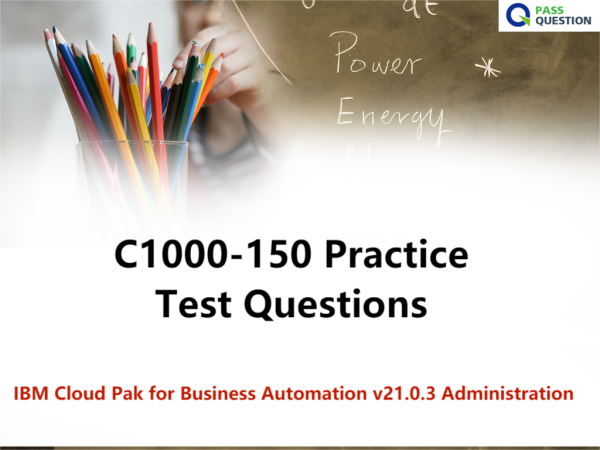C1000-150 IBM Cloud Pak for Business Automation v21.0.3 Administration is the new exam replacement of the C1000-091 exam. PassQuestion has designed the C1000-150 Practice Test Questions to ensure your one attempt success in the IBM Cloud Pak for Business Automation v21.0.3 Administration Exam. You just need to learn all the IBM C1000-150 exam questions and answers carefully. You will get fully ready to attempt your IBM C1000-150 exam confidently. The best part is that the C1000-150 Practice Test Questions include the authentic and accurate answers that are necessary to learn for clearing the IBM C1000-150 exam.

IBM Cloud Pak for Business Automation v21.0.3 Administration (C1000-150)
The IBM Certified Administrator on IBM Cloud Pak for Business Automation v21.0.3 is an intermediate-level certification for an experienced system administrator who has extensive knowledge and experience of IBM Cloud Pak for Business Automation v21.0.3. This administrator can perform tasks related to Day 1 activities (installation and configuration). The administrator also handles Day 2 management and operation, security, performance, updates (including installation of fix packs and patches), customization, and/or problem determination. This exam does not cover installation of Red Hat OpenShift.
Recommended Skills
Basic concepts of Docker and Kubernetes
Ability to write scripts in YAML
Working knowledge of Linux
Working knowledge of OpenShift command-line interface, web GUI, and monitoring
Basic knowledge of Kafka, Elastic Search, Kibana, and HDFS
Working knowledge of relational databases and LDAP
Basic knowledge of event-driven architecture.
Exam Information
Exam Code: C1000-150
Number of questions: 60
Number of questions to pass: 39
Time allowed: 90 minutes
Languages: English
Certification: IBM Certified Administrator – IBM Cloud Pak for Business Automation v21.0.3
Exam Sections
Section 1: Planning and Install 26%
Section 2: Troubleshooting 27%
Section 3: Security 17%
Section 4: Resiliency 10%
Section 5: Management 20%
View Online IBM Cloud Pak for Business Automation v21.0.3 C1000-150 Free Questions
1. Which statement is true when installing Cloud Pak for Business Automation via the Operator Hub and Form view?
A. Ensure the Persistent Volume Claim (PVC) is defined in the namespace.
B. Use a login install ID that has at minimum Editor permission.
C. The cluster can only be set up using silent mode.
D. The secret key for admin.registrykey is automatically generated.
Answer: A
2. After installing a starter deployment of the Cloud Pak for Business Automation, which statement is true about using the LDAP user registry?
A. Only three users are predefined: cp4admin, user1, and user2, but others can be added manually.
B. Predefined users’ passwords can be modified by updating the icp4adeploy-openldap-customldif secret.
C. New users can be added by using the route to the openldap pod from an OpenLDAP browser.
D. New users can be added by the predefined cp4admin user through the admin console of ZenUI.
Answer: B
3. What might cause OpenShift to delete a pod and try to redeploy it again?
A. Liveness probe detects an unhealthy state.
B. Readiness probe returns a failed state.
C. Pod accessed in debug mode.
D. Unauthorized access attempted.
Answer: A
4. After the root CA is replaced, what is the first item that must be completed in order to reload services?
A. Delete the default token.
B. Replace helm certificates.
C. Delete old certificates.
D. Restart related services.
Answer: A
5. While not recommended, if other pods are deployed in the same namespace that is used for the Cloud Pak for Business Automation deployment, what default network policy is used?
A. deny-all
B. allow-all
C. allow-same-namespace
D. restricted
Answer: B
6. What feature of a Kubernetes deployment of CP4BA contributes to high availability?
A. Dynamic Clustering through WebSphere
B. WebSphere Network Deployment application clustering
C. Usage of EJB protocol
D. Crashed pod restart managed by Kubernetes kubelet
Answer: D
7. How are Business Automation Insights business events processed and stored for dashboards?
A. Kafka is responsible for aggregating and storing summary events.
B. Flink jobs write data to Elasticsearch.
C. Business Automation Insights uses a custom Cloudant database to store events.
D. The HDFS datalake serves this purpose.
Answer: B




